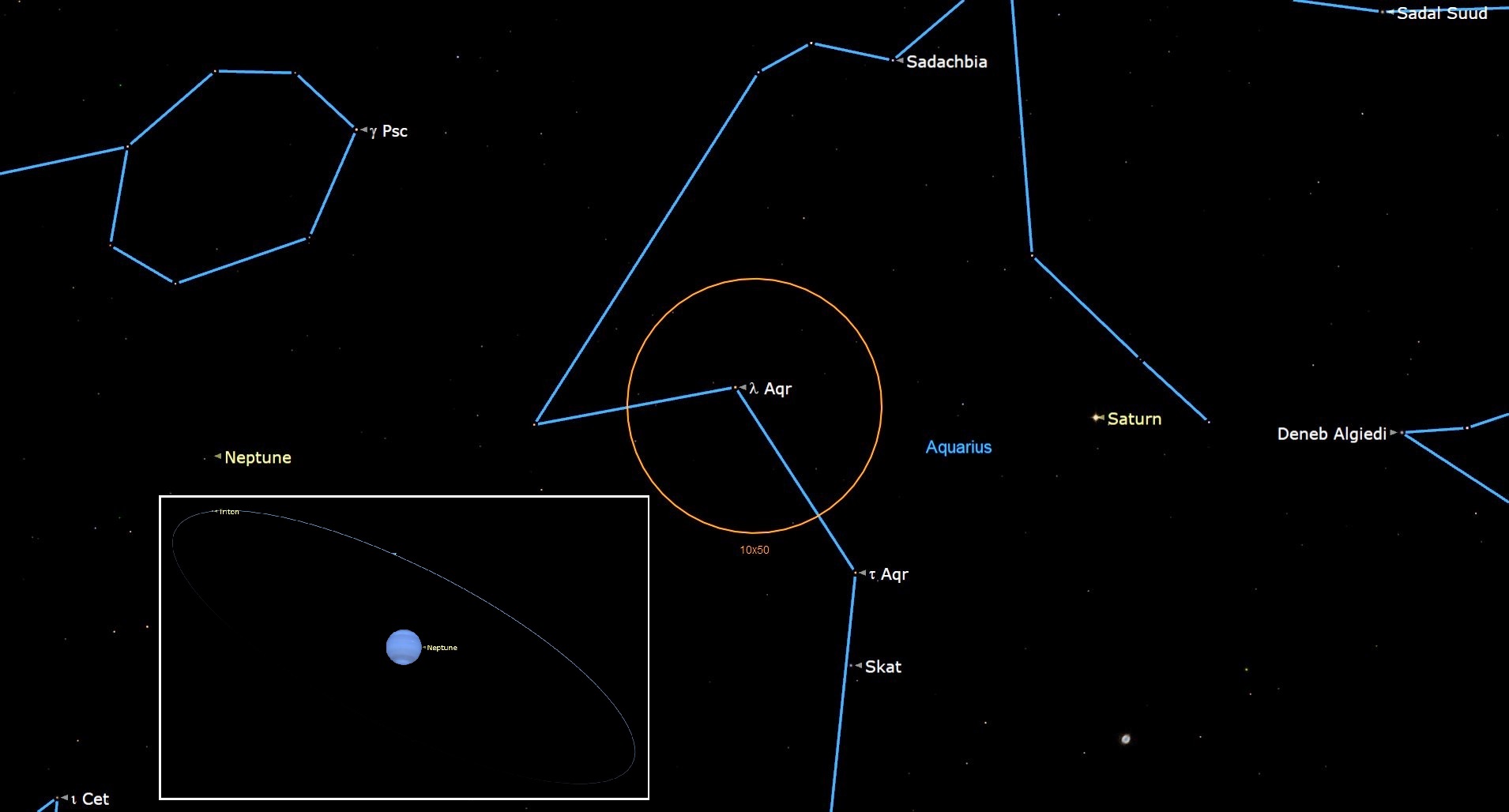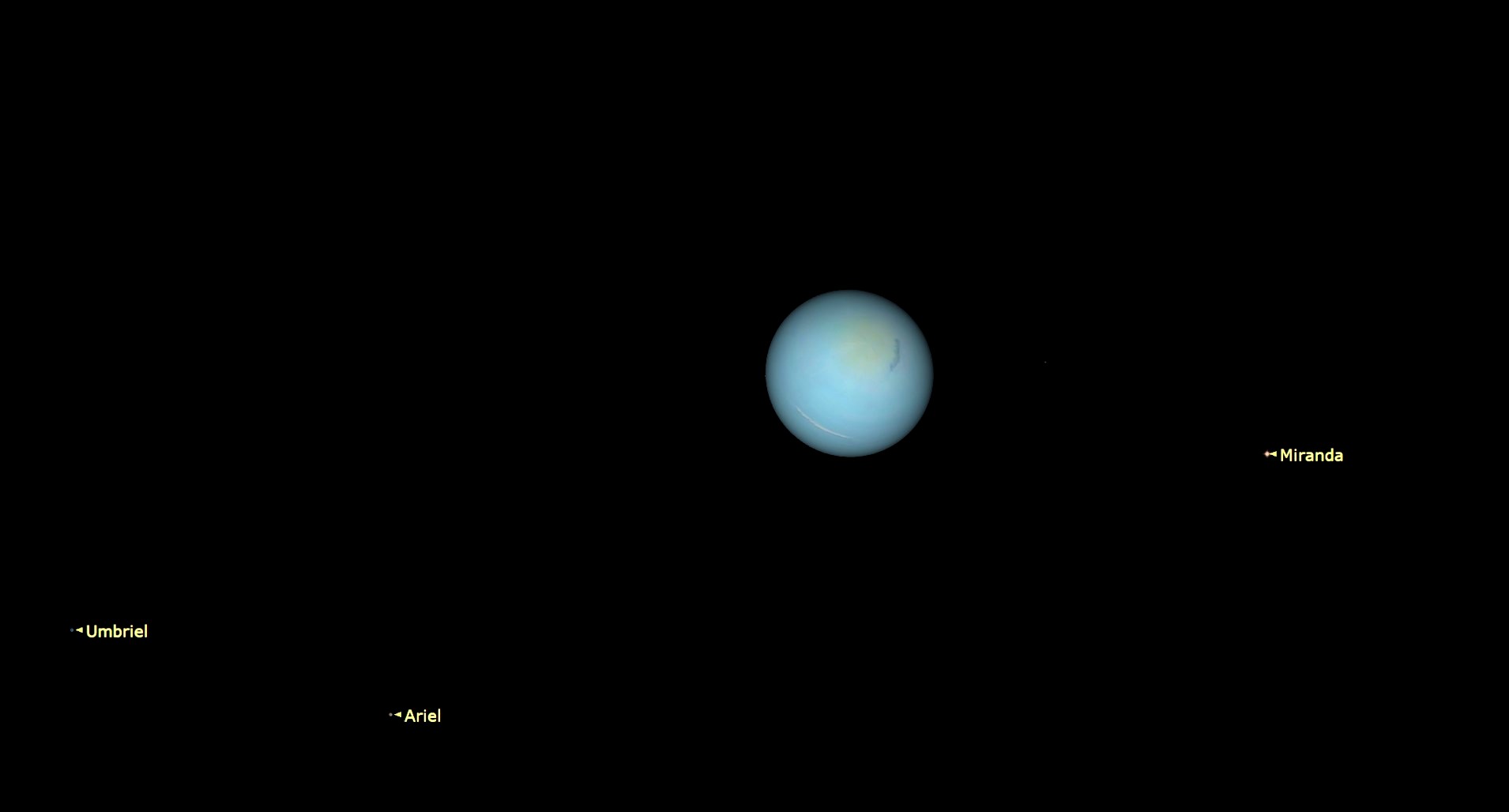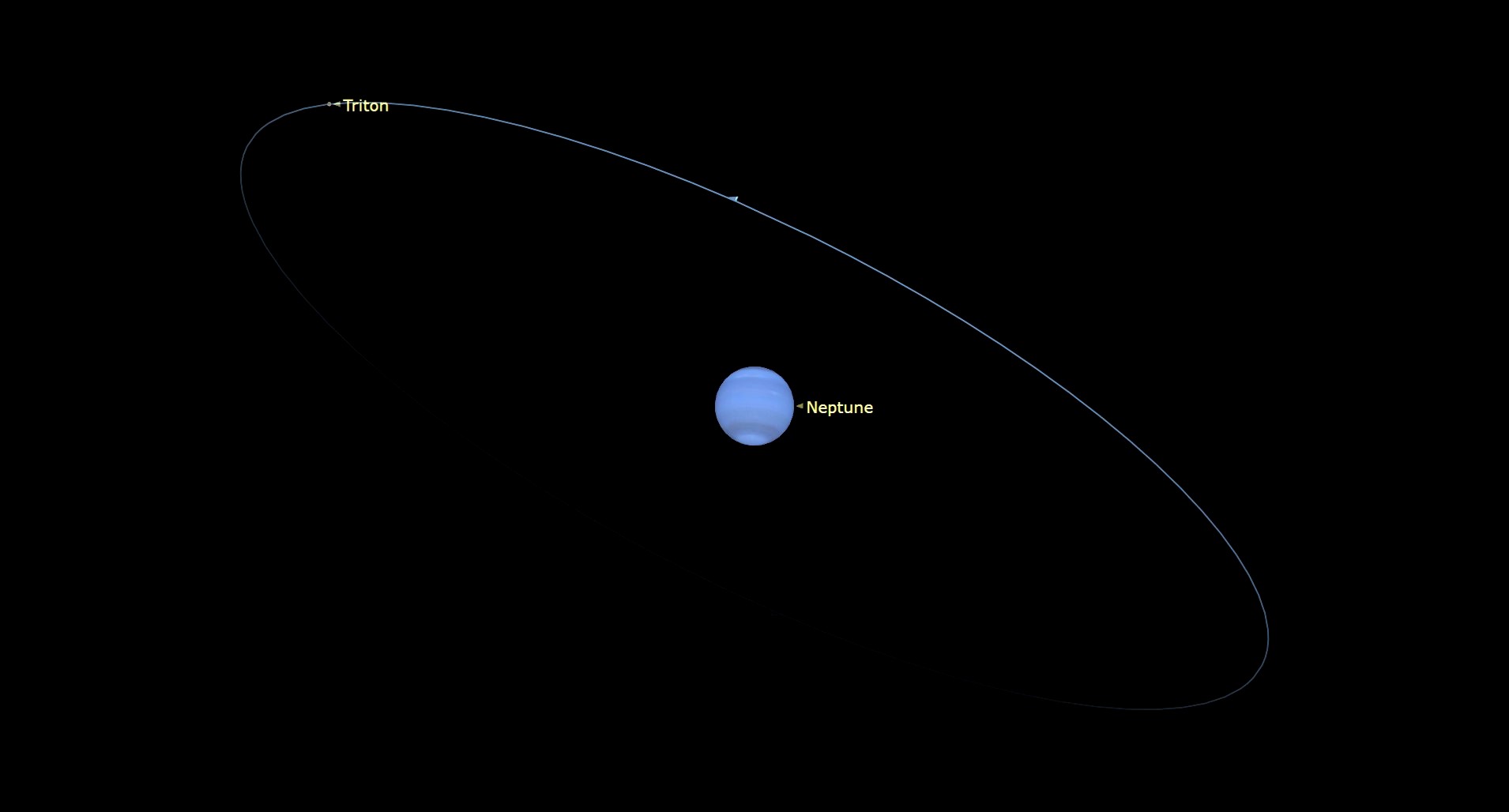Distant Neptune and Uranus make for excellent night sky sights this week. Here's how to see them

Most people have seen the five brightest naked-eye planets, and yet there is a sixth planet that can be spied without optical aid — the planet Uranus. Of course, you'll have to know exactly where to look for it.
Fortunately, it is currently well placed for viewing in our sky and with the bright moon now out of the way this week; it will be a good time to look for it.
Barely visible to the unaided eye on very dark, clear nights, Uranus is currently shining at magnitude +5.7 (On this scale, larger numbers represent dimmer objects.).
So, Uranus verges near the limit of what's visible with the naked eye under dark skies. It's now visible during the late-evening hours in the constellation of Aries, the Ram. By around midnight, it will be situated about one-third of the way up from the eastern horizon to the point directly overhead, and is positioned roughly midway between two prominent sky landmarks. To its west or right is the brilliant planet Jupiter, while to the east or left is the Pleiades star cluster.
Related: Night sky, September 2023: What you can see tonight [maps]
It is best to study the accompanying map first, then scan that region with binoculars; you'll be looking for a small starlike object shining with a pale-greenish tinge.

Want to see the planets of the solar system in the night sky? We recommend the Celestron Astro Fi 102 as the top pick in our best beginner's telescope guide.
Using a magnification of 150-power with a telescope of at least three-inch aperture, you should be able to resolve it into a tiny, featureless disk. Uranus, which lies nearly 2 billion miles (3.2 billion km) from the sun, has a diameter of 31,800 miles (51,200 km) and according to flyby magnetic data from NASA's Voyager 2 probe in 1986, has a rotation period of 17.4 hours.
Breaking space news, the latest updates on rocket launches, skywatching events and more!
At last count, Uranus has 27 moons, all in orbits lying in the planet's equator in which there is also a complex of eleven narrow, nearly opaque rings, which were discovered in 1978.
Uranus likely has a rocky core, surrounded by a liquid mantle of water, methane, and ammonia, encased in an atmosphere of hydrogen, helium, methane and small amounts of acetylene and hydrocarbons. A bizarre feature is how far over Uranus is tipped. Its north pole lies 98 degrees from being directly up and down to its orbit plane. Thus, its seasons are extreme: when the sun rises at its north pole, it stays up for 42 Earth years; then it sets and subsequently, the north pole is in darkness for 42 Earth years.
First thought to be a comet
The man who discovered Uranus was William Herschel, an English organist who was also an amateur astronomer.
In late winter of 1781, Herschel finished building a new seven-inch reflecting telescope and began to explore the sky with it. On the night of March 13, he had his telescope trained on the constellation of Gemini, the Twins. There to his great surprise he noticed a star with a greenish hue that was not charted on any of his sky maps.
An assiduous amateur observer, Herschel was quick to realize that what he found could not be a star, for it appeared in his telescope as a glowing disk as opposed to a twinkling point of light. Continuing to observe his find night after night, Herschel discovered that it was moving among the stars of Gemini. Finally, he decided that he had discovered a new comet and wrote up a detailed report of his observations.
The report of a new comet excited astronomers all over Europe, and they eagerly trained their telescopes on Herschel's discovery. But the more they studied it, the more they began to wonder if it really was a comet. For one thing, it seemed to be following a nearly circular orbit out beyond Saturn. Finally, it became clear that Herschel had not discovered a comet but a new planet.
For a while, it actually bore Herschel's name. Herschel himself proposed the name Georgium Sidus — "The Star of George" — after his benefactor, the King of England. However, the custom for a mythological name ultimately prevailed and the new planet was finally christened Uranus after the Greek god of the sky.
Prior to Uranus' discovery, the outermost planet was considered to be Saturn, named for the ancient god of time and destiny, but Uranus was the father of Saturn and considered the most ancient deity of all. It takes 84 years to make one circuit around the sun.
Uranus led to Neptune
Interestingly, the discovery of Uranus in 1781 eventually led to the discovery of yet another new world, some 65 years later. Since it appeared bluish in color, the new planet was named Neptune after the god of the sea. More on this in a moment.
But in contrast to Uranus, which is right on the threshold of naked-eye visibility, Neptune is much too faint to be perceived without any optical aid.
At magnitude +7.8, Neptune is more than six times dimmer than Uranus. It is also slightly smaller than Uranus, with a diameter of 30,800 miles (49,600 km). With the demotion of Pluto to the category of a "dwarf" planet in 2006, Neptune acquired the title of the farthest of the "classical" planets from the sun; it currently lies at a distance of 2.74 billion miles (4.41 billion kilometers) from Earth. In the year 2011, Neptune completed one full trip around the sun since its 1846 discovery.
How to locate Neptune
Nonetheless, if you have access to a dark, clear sky and carefully examine our map, you should have no trouble in finding it with a good pair of binoculars.
Once again, study the accompanying map.
Neptune is now among the faint stars of Pisces the Fishes. In Pisces, there is a dim, albeit popular asterism known at the Circlet whose ring-like shape is easily recognized south of the southern side of the Great Square. Your clenched fist held at arm's length is equal to about 10 degrees in width. About 5 degrees (or a "half fist") below the Circlet is a +5.5 magnitude star 20 Piscium. Now center binoculars or a low-power telescope on this star and Neptune will be less than a half-degree away. It will appear as a tiny, bluish star.
But trying to resolve Neptune into a disk will be more difficult than it is with Uranus. You're going to need at least a four-inch telescope with a magnification of no less than 200 power just to turn Neptune into a tiny dot of light.
Gas world
Voyager 2 passed Neptune in 1989 and showed it to possess a deep blue atmosphere, with rapidly moving wisps of white clouds. Also evident was a Great Dark Spot, rather similar in nature to Jupiter's famous Great Red Spot. That storm has since disappeared, but new ones have appeared on different parts of the planet. Voyager 2 also revealed the existence of at least five rings and four ring arcs around Neptune, mostly composed of very fine particles.
The atmosphere of Neptune is apparently composed chiefly of hydrocarbon compounds. Based on the rotation rate of its magnetic field, a rotation rate of 16.1 hours has been assigned to Neptune. Neptune is also our solar system's windiest planet with winds whipping clouds of frozen methane across the planet at speeds of more than 1,200 miles (2,000 km) per hour.
Neptune has 14 moons, one of which, Triton, was discovered just 17 days after Neptune itself was discovered. Triton has a tenuous atmosphere of nitrogen and at nearly 1,700 miles (2,700 km) in diameter, it is even larger than Pluto. Because Triton is moving in a retrograde (backward) orbit around Neptune, there has been some suggestion that it was originally a Kuiper Belt asteroid that Neptune may actually captured in the distant past.
Perturbing Uranus
As was alluded to earlier, Neptune's discovery came about from long-term observations of Uranus. By plotting the path of a planet, astronomers can draw up tables that show them exactly where the planet will be at any given time. So, after the discovery of Uranus, they set about plotting is orbit. But this methodology didn't seem to work. Sometimes Uranus turned up ahead of its predicted position; sometimes it lagged behind. So, astronomers began to think that an unseen body lay beyond Uranus. Perhaps its gravitational field was perturbing its motion and that was the explanation of Uranus' odd behavior.
Not until the 1840's did anyone attempt to put that idea to the test. Then, as so often happens in science, two men attacked the problem at the same time without knowing of each other's work. In England, young John Couch Adams (1819-1892), a student at Cambridge University, proved by mathematics that there must be an unknown object beyond Uranus and indicated where it might be found. Meanwhile in France, the astronomer Urbain J.J. Leverrier (1811-1877) also solved the problem.
Neither knew what the other was doing, but ultimately, both men had figured out the probable path of the supposed object that was disturbing the orbit of Uranus. Both believed that the unseen body was then in the constellation of Aquarius the Water Carrier.
So, both Adams and Leverrier appealed to their fellow astronomers for help in locating the planet.
Adams forwarded his results to Sir George Airy (1801-1892), the Astronomer Royal, with specific instructions on where to look for it. For some unknown reason, however, Airy delayed a year before starting the search. Was it because of his lofty position as Astronomer Royal that he was reticent on following instructions from a mere student?
In contrast, Leverrier wrote to the Berlin Observatory requesting that they search in the place his directed. Upon receiving Leverrier's letter, Johann Gottfried Galle (1812-1910) and Heinrich d'Arrest (1822-1875) at Berlin did exactly as they were instructed and found the new planet in less than an hour!
"Almost" discoveries
A strange fact about Neptune is that it was very nearly discovered by none other than Galileo with his crude telescope, more than two-and-a-half centuries earlier.
It was while observing Jupiter and its system of four large satellites on Dec. 28th, 1612 that, in the same field of view, Galileo unknowingly recorded Neptune as an eighth magnitude star. Just over one month later on Jan. 27, 1613, Galileo recorded two stars in his telescope field, one of which was Neptune. The next night when he looked again, he noted that the two stars seemed further apart. If he had only continued to keep watch in the following nights, he would have almost certainly would have realized that one of the "stars" was indeed moving.
But Galileo should not be faulted for not recognizing Neptune, for later observers too, stumbled across it without realizing what it really was. Among them was the skilled French astronomer, Lalande (1795); the English astronomer, John Herschel (1830); and the Scottish astronomer, Von Lamont, just days before Neptune was actually discovered by Galle and d'Arrest in 1846. All thought it was nothing more than an ordinary star.
And yet, if only Galileo had followed through with his observations, the eighth planet would have been discovered before the seventh!
Want to check out Uranus and Neptune? See our guides on the best telescopes, the best binoculars, and the best telescopes for seeing planets.
And if you're looking to snap photos of Uranus, Neptune or the night sky in general, check out our guide on how to photograph the planets, as well as our best cameras for astrophotography and best lenses for astrophotography.
Joe Rao serves as an instructor and guest lecturer at New York's Hayden Planetarium. He writes about astronomy for Natural History magazine, the Farmers' Almanac and other publications.

Joe Rao is Space.com's skywatching columnist, as well as a veteran meteorologist and eclipse chaser who also serves as an instructor and guest lecturer at New York's Hayden Planetarium. He writes about astronomy for Natural History magazine, Sky & Telescope and other publications. Joe is an 8-time Emmy-nominated meteorologist who served the Putnam Valley region of New York for over 21 years. You can find him on Twitter and YouTube tracking lunar and solar eclipses, meteor showers and more. To find out Joe's latest project, visit him on Twitter.




